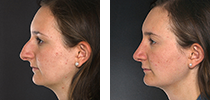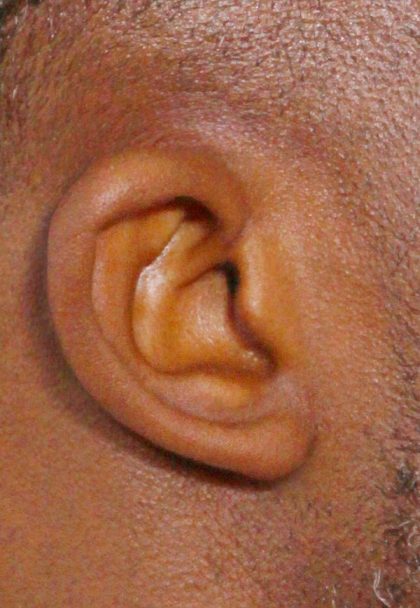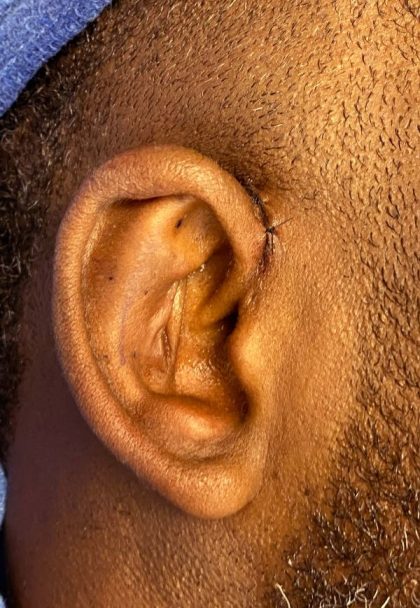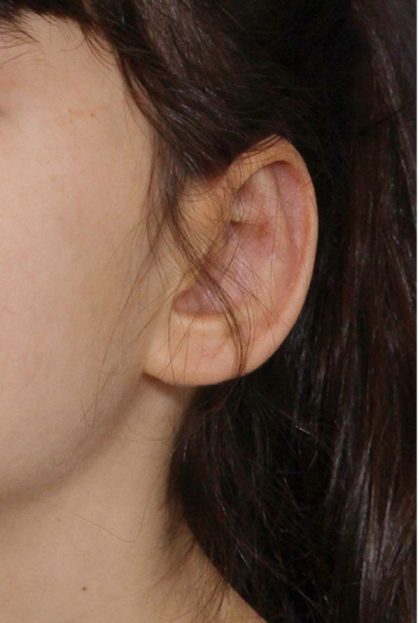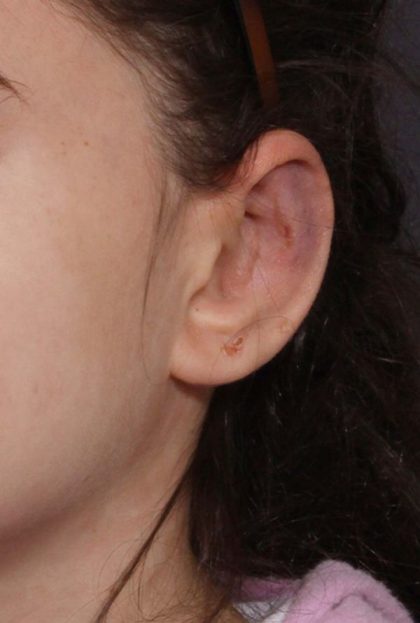Adult Otoplasty
Conveniently located to serve the areas of New York, NY

An otoplasty is a procedure that changes the size, shape, or angle of the ears to establish balance between the ears and other facial features. (1) Plastic surgeons can also correct any other abnormalities the ears may have during an otoplasty. Adult patients specifically may have struggled with the appearance of their ears throughout their lives, and become motivated later in life to address this cosmetic problem that may contribute to social stress, poor self-image, and embarrassment. After an otoplasty, adult patients may feel more confident in their appearance and less apt to hide this feature beneath long hair or hats.
At Dr. Sherman’s New York City practice, he utilizes his 40 years of experience to deliver results that enhance patients’ features and self-confidence. Dr. Sherman is adept in ear reshaping and resizing techniques, such as cutting cartilage, folding ear tissue, and carefully placing sutures. To schedule a personal consultation where Dr. Sherman and his staff can develop a treatment plan for correcting prominent or misshapen ears, call the practice at (212) 535-2300 or inquire through the online contact form.
Contents
Before and After Photos
About Otoplasty
The human ear is a complex structure composed of cartilage, skin, and blood vessels. It consists of three sections: the outer ear, middle ear, and inner ear. The outer ear, which is primarily what an otoplasty surgery addresses, comprises the visible external part known as the auricle (or pinna) and the ear canal. Prominent ears result mainly from underdeveloped ear cartilage or excessive space between the head and the outer ear. These features can cause embarrassment, whether you are a child, an adolescent, or an adult. We often attribute the cause of prominent ears to be a genetically inherited trait, but they can be caused by other factors like environmental influences or genetic mutations. (2)
Men or women can develop ears that are out of proportion with the rest of their face and can be affected in one or both ears. Depending on the condition of your ears, Dr. Sherman can address both at the same time, or he can correct asymmetry between the ears.
“Ear Pinning”
Otoplasties may also be called “ear pinning” procedures. This is because the patient who possesses prominent ears often finds that they project outward, whereas the normally situated ear is aligned closer to the skull. Ear pinning is a popular ear surgery, as around 5% of people suffer from the stigma surrounding prominent ears. (3)
Ear Surgery Techniques
When a child is born with prominent ears, ear splinting may remedy the abnormality without surgery. This must be done within the first few weeks after birth. If that time interval is missed, then surgery eventually can remedy the problem. If that initial period is missed, the surgeon may perform the operation after the age of six, when it is safe to administer anesthesia, and ear growth is adequate. The procedure is simply done early on in some cases because the ear matures at an early age–at 5-6 years old, the cartilage and ear will be fully formed enough to operate on. (1)
If the above time periods are missed, patients may seek an otoplasty as an adult. In adult patients, the incomplete development of the ear is less of a concern as the auricular cartilage, or the cartilage of the external ear, is more firm. (1) The specifics of your otoplasty procedure for prominent ears will factor in this firmness of the ear cartilage; a combination of incision, scoring, and suture techniques is usually required. These actions will decrease the size of the cephalo-auricular angle, or the distance between the ear and the skull, to an angle that is more fitting to the patient. (1)
Dr. Sherman can help create a more natural-looking antihelical fold, which is where the cartilage bends to make a small ridge in the normal ear. (1) Further, he can also address any helical rim abnormalities, which would occur on the outer curve of the ear. Before each otoplasty, Dr. Sherman will perform an extensive evaluation of the ear in the context of each individual’s facial structure so that he can determine the optimal procedural plan for every unique situation. Since postoperative complications can often result in severe auricular deformities, as a matter of principle, each ear should be analyzed individually regarding its problem areas, and the surgical approach that causes the least injury to the cartilage should be used. (1)
Dr. Sherman also offers specific procedures for the correction of large ears (Macrotia) and Stahl’s ear.
Benefits of Otoplasty
Adult patients may benefit from an otoplasty in the following ways:
- Improved overall appearance
- Corrected asymmetry
- Enhanced facial harmony
- Increased confidence in appearance
- Widened range of available hairstyles and accessories
- Natural-looking results
Candidates
If you are unhappy with the shape or size of your ears or find yourself regularly hiding them beneath long hairstyles or hats, you may be a candidate for ear surgery. Otoplasty candidates may experience feelings of low self-esteem relating to the appearance of their ears, or feel socially limited or unconfident because of their ears. (2) It will also help if you:
- Do not smoke
- Are in general good health
- Have realistic expectations
- Are communicative about your aesthetic goals
Personal Consultation
During your consultation, Dr. Sherman will provide an in-depth explanation of what happens during an otoplasty procedure. He will further examine your ears and demonstrate how this procedure will apply to your situation. Dr. Sherman will encourage you to share your thoughts and opinions about the issues you have had with the appearance of your ears. He will take your goals into consideration and let you know what is realistically achievable with an otoplasty procedure. Lastly, he will let you know what you can do to prepare, and how to optimize your recovery.
A personal consultation with Dr. Sherman is a crucial first step in the process of undergoing an otoplasty. You will need to call the office in New York City at (212) 535-2300 to schedule an appointment. Alternatively, you can fill out our online form and we will get back to you as soon as possible.
Preparation
Dr. Sherman will inform you of the ways you can prepare for an otoplasty procedure after your initial consultation. However, otoplasties generally require the following preparation steps:
- Testing: For patients over the age of 50, Dr. Sherman will order blood tests before the procedure.
- Medical Clearance: Patients who are over 50 years old who elect sedation for their procedure must make sure they can obtain medical clearance from their primary care provider.
- Quit Smoking: For patients who smoke or use other forms of nicotine, Dr. Sherman will recommend ceasing all smoking and nicotine consumption activities at least a few weeks before the otoplasty procedure takes place. These products can have negative effects on blood circulation that can impact the healing process.
- Adjust Medications: There are some medications you may need to change or stop altogether before your procedure. Dr. Sherman will inform you which medications are acceptable and which are not.
You will not need to cut or shave your hair before your procedure–simply arrive at your appointment on time with all jewelry removed.
Procedure
While every otoplasty procedure will be uniquely tailored to each patient, Dr. Sherman and his staff usually approach otoplasties in the following sequence of events:
- Anesthesia: The anesthesiologist will administer the proper anesthesia to ensure your comfort throughout the procedure.
- Incision: Dr. Sherman will make a small, discreet incision in the back of the ear to access the outer cartilage. This will allow him accessibility to the concha, which is the surface of the ear near the canal, and other parts of the ear.
- Sutures: Dr. Sherman will place sutures in the cartilage that will help give the ear a more aesthetically pleasing structure. He will repeat this process on the other ear if it is also affected by prominence.
The otoplasty procedure will be around 2 hours long. In an adult otoplasty, Dr. Sherman can usually perform the operation while the patient is under local anesthesia. (2) He can carry out the restructuring entirely from the posterior, or back, of the ear. However, if necessary, he can also perform the procedure from the front of the ear. The suturing technique that Dr. Sherman will use is called the Mustarde technique; this technique employs the use of permanently angled sutures that will uphold the newly improved structure of the ear. (1)
Recovery
Otoplasties are outpatient procedures, meaning that patients are able to go home once the surgery is complete. However, you may experience swelling, bruising, and general discomfort in the treated areas. During this time, you will need to prioritize resting. Dr. Sherman will let you know what medications are permissible to take while you are recovering.
After 4-5 days, Dr. Sherman will remove your bandages and evaluate the progress of your recovery. He will then provide you with a special protective headband that is designed to act as a protective barrier for the incisions. You should continue to wear this headband every night during the first month of your recovery. After 10 days, Dr. Sherman will remove the sutures from the outside of the ear. After around 2-3 weeks, the final results of your otoplasty should be fully visible, as swelling and bruising will have gone down.
Results
After otoplasty, the ears appear more balanced and less prominent. Patients may notice the positive impacts of their surgery manifesting in everyday life with a significant improvement in confidence, courage, and attitude. (2) The results of this kind of procedure are essentially permanent. Depending on the features of the ear that the patient strives to correct, the ear can appear smaller, closer to the head, and more in line with other facial features.
In one study, 95.2% of adult patients felt that their quality of life had improved after their otoplasty. (3)
Cost of Ear Surgery in New York
The cost of an individual’s ear surgery relies upon many factors, such as the precise condition of the ears and whether the condition affects one ear or both. After your personal consultation, Dr. Sherman will provide you with an accurate cost estimate for the entire scope of your procedure. We offer certain financing options that may help you plan for your procedure expenses.
To schedule a consultation with Dr. Sherman at our New York City office, call (212) 535-2300 or inquire through our contact form.
References
- Kennedy KL, Katrib Z. Otoplasty. PubMed. Published 2021. https://www.ncbi.nlm.nih.gov/books/NBK538320/
- Naumann A. Otoplasty – techniques, characteristics and risks. GMS Current Topics in Otorhinolaryngology, Head and Neck Surgery. 2008;6:Doc04. https://www.ncbi.nlm.nih.gov/pmc/articles/PMC3199845/
- Kajosaari L, Pennanen J, Klockars T. Otoplasty for prominent ears – demographics and surgical timing in different populations. International Journal of Pediatric Otorhinolaryngology. 2017;100:52-56. doi:https://doi.org/10.1016/j.ijporl.2017.06.014


